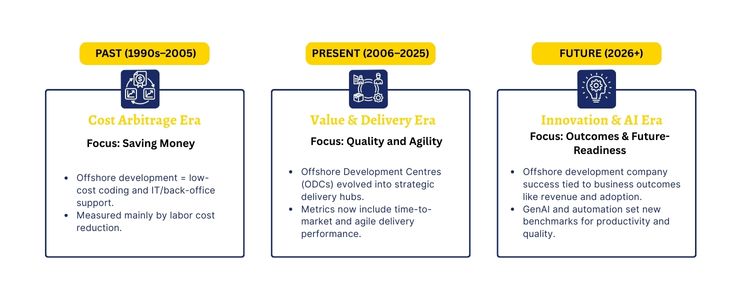
This global offshoring has ceased to be a simple cost play but a value-and-innovation engine. By FY2025, the revenue of the Indian technology industry is projected to reach $282.6B. Meanwhile, 1,900 of the 3,200 global GCCs are now based in India, and that is an overwhelming global testimonial to the power of the total exports of Services have increased to $340B in FY2024, which indicates the long-term interest in offshore development firms and engineering labour. This blog explains what to measure and how to demonstrate success when you establish an Offshore Development Centre (Setup ODC) or enter into a relationship with an offshore development centre in India.
The past offshore development models have been evaluated based on rate cards and headcount. Executives are today assessing time-to-market, product quality, innovation throughput and business impact with GCCs and ODCs serving as global innovation hubs, not only as back offices. This evolution is confirmed by the fact that India is increasing its GCC presence (estimated to be more than 2,100 by FY 2028, approximately 8 per cent CAGR).
1) Business Impact 2) Delivery & Quality 3) Talent & Capability 4) Collaboration & Integration 5) Future-Readiness
The process begins with clarity of business goals. The latter are then converted into quantifiable objectives and key results (OKRs). Every OKR has the performance indicators, which may be business, delivery-related, or talent-orientated. After the definition of such KPIs, companies need to set baselines, collect benchmark data, and combine such tools as Jira, Git, CI/CD pipelines, and HR systems to record the outcomes. Dashboards are supposed to give real-time visibility on progress. Quarterly reviews assist organisations to adapt and continuous change in such areas as developer experience, automation, and upskilling make the offshore model competitive.
Global outsourcing in IT has been strong and is expected to continue to grow through 2029. This is a sign of the continued need of offshore development services and product engineering management. The Indian tech engine itself is expected to reach a revenue of more than 300B in FY 2026, which is driven by the growth of the Engineering and R&D sector as well as GCC expansion, which will minimise the risk of execution of a new offshore development centre.
Achievement in a contemporary offshore development model is multi-dimensional. A KPI stack combining business impact, delivery excellence, talent maturity, collaboration quality and future-readiness will show real value – far beyond cost savings. India has scale, talent and momentum, and with an offshore development centre India can speed up innovation and growth – as long as you measure what matters and keep on improving.
Transform your enterprise with Inductus GCC. Whether it is establishing ODC or expanding innovation, we ensure you grow globally with confidence. Our ability to redefine global capability is by matching offshore development with business outcomes. Our GCC experience is guaranteed to deliver success whether it is faster product development, enhanced quality or extended innovation capability. Join us in co-location to create offshore development centres that are fast, resilient and provide long-term strategic value.
A GDC refers to a single-minded offshore deployment, which provides proficient business, technology and operational services to corporate bodies on a global basis. BFSI, IT services, healthcare, telecom, retail, manufacturing, and other upcoming technologies, including AI and blockchain. They do not only target cost savings but now aim at innovation, automation, R&D, digital transformation, and high-value consulting. They design and create cloud, artificial intelligence, analytics, cloud security, and process automation. A large supply of STEM graduates, multilingual workers and niche skills in AI, ML, cloud, and analytics. Aditi, with a strong background in forensic science and biotechnology, brings an innovative scientific perspective to her work. Her expertise spans research, analytics, and strategic advisory in consulting and GCC environments. She has published numerous research papers and articles. A versatile writer in both technical and creative domains, Aditi excels at translating complex subjects into compelling insights. Which she aligns seamlessly with consulting, advisory domain, and GCC operations. Her ability to bridge science, business, and storytelling positions her as a strategic thinker who can drive data-informed decision-making.
The Shift: From Cost Arbitrage to Outcome Arbitrage
The Metric Stack: What to Measure (and Why)
Why India for an Offshore Development Centre (Economic Advantages)

Quick-Glance KPI Table (Use in your ODC Scorecard)
Dimension
KPI
Target/Signal of Success
Business Impact
Release cycle time
↓ 20–40% within 2–3 quarters
Business Impact
Revenue from ODC-built features
Rising QoQ with clear attribution
Delivery & Quality
Change failure rate
< 15% with stable complexity
Delivery & Quality
MTTR
< 1 day for Sev-2, hours for Sev-1
Talent & Capability
Upskilling velocity
20–40 hrs/engineer/quarter
Collaboration
Onshore CSAT/NPS
≥ 8/10 consistently
Future-Readiness
Test automation
> 70% of regression suite
Future-Readiness
GenAI-assisted dev usage
Documented productivity & quality gains
Flow of Offshore Measurement in Practice
The Market Context: Why ``Now`` Matters
What's Next: The Future of Measuring Offshore Success.
Conclusion
frequently asked questions (FAQs)

Aditi
Hey, like this? Why not share it with a buddy?
Related Posts
Recent Blog / Post
- Why Mid-Sized Companies are Embracing the GCC Model October 16, 2025
- What Is A Global Capability Center (GCC), and Why Is It Essential For Modern Business? October 16, 2025
- Gurugram’s Tech Ascent: Decoding the New Haryana GCC Policy October 15, 2025
- Scaling Your Tech Team: A Beginner’s Look at the Offshore Development Center October 15, 2025
- Agile Methodologies for GCCs: A Blueprint for Success October 6, 2025
- The Legal and Compliance Checklist for a New GCC Setup October 4, 2025
- The Rise of Niche GCCs: A Focus on Specialised Capabilities October 4, 2025
- The Impact of Regulatory Changes on GCC Operations October 4, 2025
- Cybersecurity for GCCs: A Proactive Approach to Data Protection September 30, 2025
- Beyond Cost: Measuring the True ROI of Your GCC Investment September 29, 2025
- The Future of GCCs in the Retail Sector: A Strategic Playbook September 29, 2025
- David vs Goliath: Mid-Sized GCCs Quietly Outperform the Big Brands September 29, 2025
- Infineon’s Big Bet on India: Inside Its First GCC in GIFT City September 29, 2025
- From Campuses to Capability Centres: How Indian Universities Power the Global GCC Ecosystem September 29, 2025
- Retail Meets Digital: Costco’s GCC in Hyderabad Marks a Global Shift September 29, 2025
















